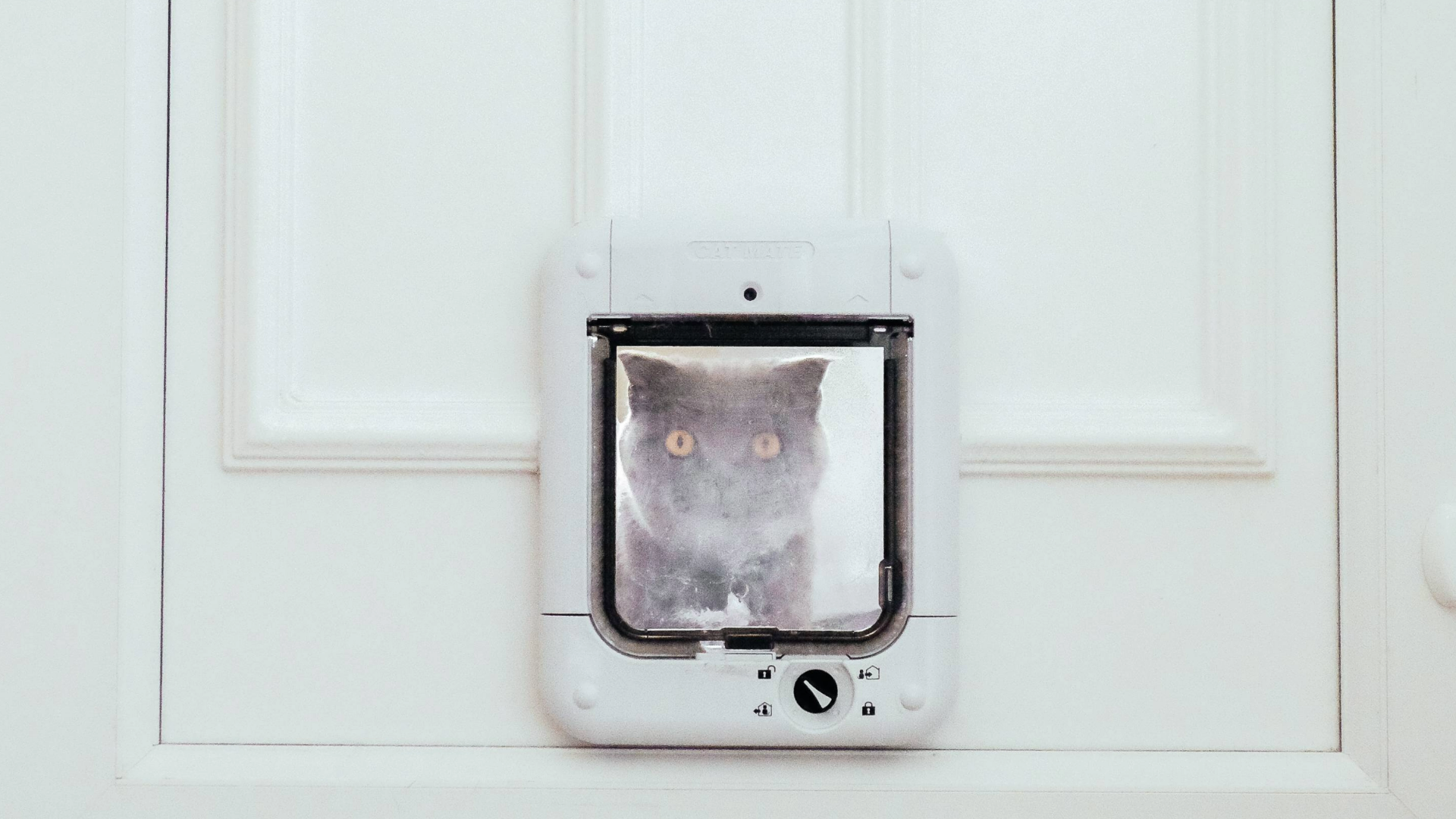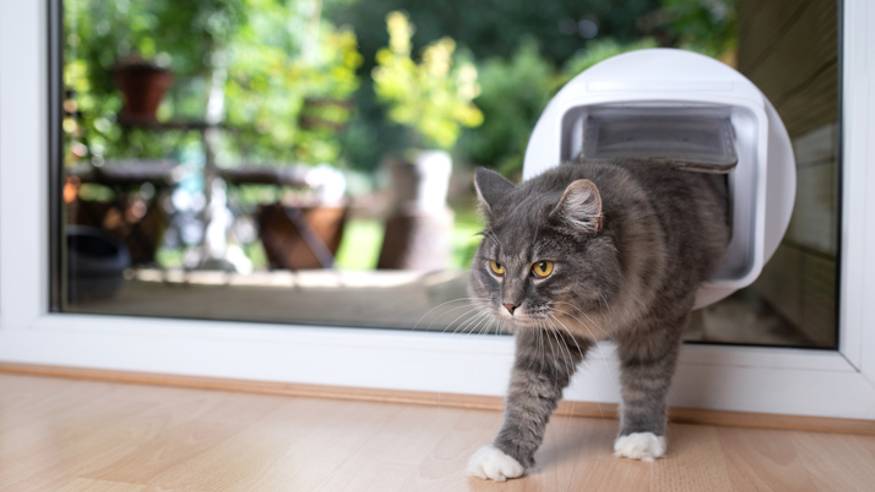
If you want to learn how to train a cat to use a cat door, you’ve come to the right place! Below, our vet shares her top training tips, along with what to do if your feline doesn’t like using one.
If you have an outdoor cat, there are many reasons why you should get a cat flap. Not only does it save you the trouble of getting up and down to let them out, but it also gives them the freedom to explore whenever they want. As a result, it encourages natural behaviors, like chasing and hunting, which promote exercise and reduce stress.
Before you get started, it’s worth investing in one of the best microchip cat flaps, which will prevent neighborhood moggies from intruding into your home and help your cat feel more at ease. If you opt for a standard cat flap, we recommend one with a four-way lock and a weatherproof seal.
How to teach a cat to use the cat door
When it comes to training, Dr. MacMillan advises going at a pace your cat is comfortable with. If you’re unsure how your feline is feeling and responding, our cat body language guide can help you figure it out. While most cats are quick learners and will happily use the door, others might need a bit of encouragement (which is where the best cat treats come in handy!).
Step one: “Start by holding the door open for them and calling them over to it with treats and verbal encouragement. Your cat may sniff and explore the open cat door.
Step two: Try holding the treat on the other side of the door and encourage them to step through, with treats and praise. Repeat this multiple times, encouraging them forward and back through the door. Continue this until they seem confident going in both directions.
Step three: Next, you can start to gently lower the flap into a partially closed position so that your cat has to learn to push against the door themselves.
Step four: You can then try with the door closed, sit on the other side of it, and encourage your cat to come through by themselves with treats and praise.”
Why use a cat door?
Apart from the obvious advantage that you won’t need to keep getting up in the middle of dinner to let your cat in or out, cat doors can be better for your cat as well. Most cats prefer to be in control of when they enter and exit, and it can help them combat boredom. If you’re away at work all day, a cat door means your kitty can easily let herself in and out to toilet and for exercise.
There are lots of different designs on the market, but they fall into two approximate categories – basic design or microchip operated. Basic doors are cheap to buy but as they’re basically just a hole in the door they will let any other animal in or out as well as your cat!
Microchip cat doors work on your cat’s individual microchip and will let only registered pets in and out. Do remember that any type of cat door will need some basic DIY skills in order to fit it. If you live in a rented property, you’ll also have to ask your landlord first or try one of these cat door alternatives.

Why won't my cat go through the cat flap?
Cats can be contrary creatures! You might have spent hours researching the best cat flaps and even more time installing them, only for your pampered puss to turn her nose up. She’s not really being naughty, though – it’s more likely she just doesn’t realize that the cat flap is a portal to adventure!
If your cat used to use the cat flap quite happily and has now stopped, then she’s trying to tell you something. The problem could be with the flap itself – has it worn sharp edges? Has your cat put on weight and now finds the door a tight fit? Is she getting arthritic and finds it too high to squeeze through?
The problem could also be that she’s scared to go outside as she’s had a bad experience such as being attacked by another cat. If you can’t find anything wrong with the flap itself, then consider replacing it with one with a transparent panel. This will enable a nervous cat to have a good look around before committing herself! Traumatized cats can take a long time to settle again, so be patient and don’t try to force her.
How to prop open a cat flap
If your kitty is still nervous, you can also prop open the flap completely until she learns that it’s a door. It’s important to do this safely, as a flap swinging down mid-exit is enough to rattle the most placid of pusses! Depending on the type of flap, you may be able to remove the door completely.
Otherwise, use pegs or robust sticky tape to secure it. Once she’s happy going through the open door, secure a piece of cloth over the gap. This will get her used to going through a door with a barrier, but it won’t be enough to frighten her if she touches it. Once your cat is really confident, put the door back in place.

How long does it take for a cat to use a cat door?
This is a slightly ‘how long is a piece of string’ question, as it depends on your cat’s age, experience and personality. Older, bolder and more curious kitties will learn in a couple of hours.
Younger or more nervous cats could take a week or more. Be patient and let your cat work it out for herself as much as possible. Try and avoid opening the door when she ‘asks’ you to, or you’ll be making a rod for your own back!
How do I get my cat to push the cat flap?
One of the main reasons that cats won’t push against the cat flap is that they’re pretty intelligent! The cat flap looks solid to them, and they’re not planning to waste their energy or risk getting hurt, thank you very much. The solution here is to out-think your cat as follows:
- Secure the door out of the way as above, and then lower it by fractions once your cat is happy to go through.
- Temporarily replace the door with something flimsy such as a piece of cloth which won’t look as solid.
- Bat the door with your hand to make it move, so that your cat can work out that it’s not fixed.
- Eventually, she should get the message and open it of her own accord.
Cat doors can not only save you the trouble of constantly letting your furry friend in and out, they also provide your cat with access to freedom and exercise. It’s well worth looking into installing one in your home. Just remember to take your cat’s size, weight and health into account when choosing the perfect model, and both your lives will be easier!
You might also want to read: How to install a pet door and how do microchip cat flaps work?







